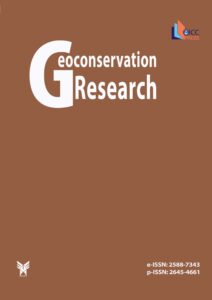Geoconservation and Geotourism on Fossil Forest of the Aragoncillo Range, Molina-Alto Tajo UNESCO Global Geopark (central Spain)
Authors
Abstract
The Fossil Forest of the Aragoncillo Range is one of several paleontological sites of exceptional scientific value in the Sierra de Selas (Province of Guadalajara, central Spain). This shows an accumulation of silicified tree trunks along with well-preserved macro- and microflora of lower Permian age. This ancient forest, dominated by tree ferns and conifers, was destroyed by volcanic eruptions that took place in many continental areas at this time. This site is in the Molina-Alto Tajo UNESCO Global Geopark, but it is highly vulnerable and has suffered continued impact from plundering. The lack of implementation of legislation that guarantees its conservation does not allow interested visitors to enjoy the site and understand the characteristics of life and climate of such a unique ecosystem from this time in Earth history.
Read the full text of the articleKeywords
Main Subjects
References
Calderón S (1898). Existencia de terreno carbonífero Molina de Aragón. Actas Real Sociedad Española de Historia Natural. 27:147–150.
Carcavilla L, Sopeña A, Sánchez-Moya Y, Vegas J, Díez-Herrero A & Moratalla J (2016). Cartografía digital y valoración de los yacimientos paleontológicos amenazados de la sierra de Aragoncillo. Proyecto de Investigación del Patrimonio Arqueológico y Paleontológico. Comunidad de Castilla-La Mancha: Informe IGME.
Castro JM, García A, Gómez JJ, Goy A, Molina JM, Ruiz PA & Sopeña A (2008). Sucesiones mesozoicas de las cordilleras Bética e Ibérica, In Contextos geológicos españoles. Una aproximación al patrimonio geológico nacional de relevancia internacional (pp 73–90). Madrid: IGME.
Cohen KM, Finney SC, Gibbard PL & Fan JX (2013). The ICS International Chronostratigraphic Chart. Episodes. 36:199–204.
Druitt TH, Avard G, Bruni G, Lettieri, P & Maez F (2007). Gas retention in fine-grained pyroclastic flow materials at high temperatures. Bulletin of Volcanology. 69:881–901. doi:10.1007/s00445-007-0116-7
García-Esteban LG, de Palacios P, Philippe M, Guindeo A & Fernández, FG (2006). New xylological data and the biogeography of the Iberian Peninsula during the Early Cretaceous. Geobios. 39:805–816. doi:10.1016/j.geobios.2005.09.003
García-Cortés A, ed. (2008). Contextos geológicos españoles. Madrid: IGME.
García-Ortiz E, Fuertes-Gutiérrez I & Fernández-Martínez E (2014). Concepts and terminology for the risk of degradation of geological heritage sites: fragility and natural vulnerability, a case study. Proceedings of the Geologists' Association. 125:463–479.
Gray M (2005). Geodiversity and geoconservation: what, why, and how? In: The George Wright Forum. 22:4–12. George Wright Society.
Ramos A, Doubinger J & Virgili C (1976). El Pérmico inferior de Rillo de Gallo (Guadalajara). Acta Geológica Hispánica. 11:65–70.
Ramos A (1979). Estratigrafía y paleogeografía del Pérmico y Triásico al Oeste de Molina de Aragón (prov. de Guadalajara). Seminarios de Estratigrafía. Serie Monografías. 6, 313 pp.
Sacher L (1966). Stratigraphie und Tektonik der nordwestlichen Hesperischen Ketten bei Molina de Aragón/Spanien. Teil 1: Stratigraphie (Paläozoikum). Neues Jahrbuch für Geologie und Paläontologie, Abhandlungen. 124:151–167.
Saiz A et al. (2015). Guía turística del Geoparque de la Comarca de Molina-Alto Tajo. 300 pp. Asociación de Desarrollo Rural Molina de Aragón-Alto Tajo.
Scotese CR (2016). PALEOMAP PaleoAtlas for GPlates and the PaleoData Plotter Program, PALEOMAP Project.
Sopeña A, Doubinger J, Ramos A & Pérez-Arlucea M (1995). Palynologie du Permien et du Trias dans le centre de la Péninsule Ibérique. Sciences Géologiques Bulletin. 48:119–157. doi:10.3406/sgeol.1995.1926
Sopeña A & Sánchez-Moya Y (1999). El bosque petrificado de la Sierra de Aragoncillo. In: La huella del pasado. Fósiles de Castilla-La Mancha, Serie: Patrimonio Histórico. Arqueología. Castilla La Mancha. 16:125–135.
Sopeña A & Sánchez-Moya Y (2008). Pérmico y Triásico. In: Geología de Guadalajara. Obras colectivas Ciencias. 3: 95–107. UAH.
Sopeña A & Sánchez-Moya Y (2017). Un Bosque Fósil de hace 280 millones de años. Quercus. 377:62–65.
Sparks RSJ (1976). Grain size variations in ignimbrites and implications for the transport of pyroclastic flows. Sedimentology 23:147–188. doi:10.1111/j.1365-3091.1976.tb00045.x
Tricalinos J (1928). Untersuchungen über den Bau der Celtiberischen Ketten des nordöstlichen Spaniens. Zeitschrift der Deutschen Geologischen Gesellschaft. 80:409–482.
Wagner RH & Álvarez-Vázquez C (2010). The Carboniferous floras of the Iberian Peninsula: A synthesis with geological connotations. Review of Palaeobotany and Palynology. 162:239–324. doi:10.1016/j.revpalbo.2010.06.005
Wagner RH & Diez JB (2007). Verdeña (Spain): life and death of a Carboniferous forest community. Comptes Rendus Palevol. 6:495–504.
Wilson C (1980). The role of fluidization in the emplacement of pyroclastic flows: an experimental approach. Journal of Volcanology and Geothermal Research. 8:231–249.




